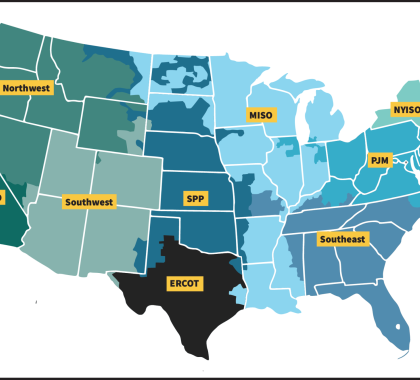When thinking of electricity and the electric grid, most people likely think of their local electric utility and local electric distribution system. But when it comes to managing the U.S. bulk electric grid, most of that responsibility lies with organizations few outside of the industry think about: Independent System Operators (ISOs) and Regional Transmission Organizations (RTOs).
These organizations are approved by the Federal Energy Regulatory Commission (FERC) to control and manage the transportation and flow of electricity over large regional areas covering several states. In simple terms, they can be thought of as the “air traffic controller” in their respective region for how electricity flows on the grid.
ISOs and RTOs were first developed in the late 1990s in response to FERC issuing its landmark Order 888, which promoted wholesale electric competition through open access non-discriminatory transmission services. Currently there are seven ISO/RTOs in the U.S., each covering a geographic region:
• ISO New England
• New York ISO
• PJM Interconnection (Pennsylvania, New Jersey, Maryland)
• MidContinent ISO (MISO)
• Southwest Power Pool (SPP)
• Electric Reliability Council of Texas (ERCOT)
• California ISO (CAISO)
Each of these ISO/RTOs are responsible for maintaining the reliability of the bulk electric grid in their respective regions. They accomplish this by constantly balancing electricity demand (usage) with available electric generation resources in their region. This balancing act happens on a continuous basis, in some cases every five minutes, hour by hour, day by day. Using complex software, ISO/RTOs use bid-based markets to determine the most economical dispatching of generating resources to match demand.
The combined footprint of these seven RTOs totals roughly two-thirds of the U.S. There are parts of the U.S. that are not covered by an RTO, including the Northwest, Southwest and Southeast sections of the U.S. In those areas, electric systems are operated primarily by individual utilities.
RTOs have many different participants, including:
• Independent generators, transmission companies and electric load-serving entities,
• Integrated utilities that combine generation, transmission and distribution functions, and
• Other entities such as power marketers and energy traders.
Because of its large geographical footprint the Municipal Energy Agency of Nebraska (MEAN) is a member of two RTOs: The Southwest Power Pool (SPP) and the MidContinent ISO (MISO). MEAN also operates in SPP’s recently formed Western Energy Imbalance Service (WEIS), which covers large portions of Colorado and Wyoming.
As a member of SPP, MISO and WEIS, representatives of MEAN attend many stakeholder meetings throughout the year and, along with other members, provide input into how the organizations are operated and managed. By working together with other utilities through these organizations, the goal is to achieve more economical power supply dispatching and to enhance electric grid resiliency.
Because RTOs have a large regional footprint, it also provides opportunities to integrate increased amounts of renewable energy onto the electric grid. The larger the footprint, the easier it is to integrate renewable energy from wind and solar generating resources due to their inherent intermittency of providing energy.

